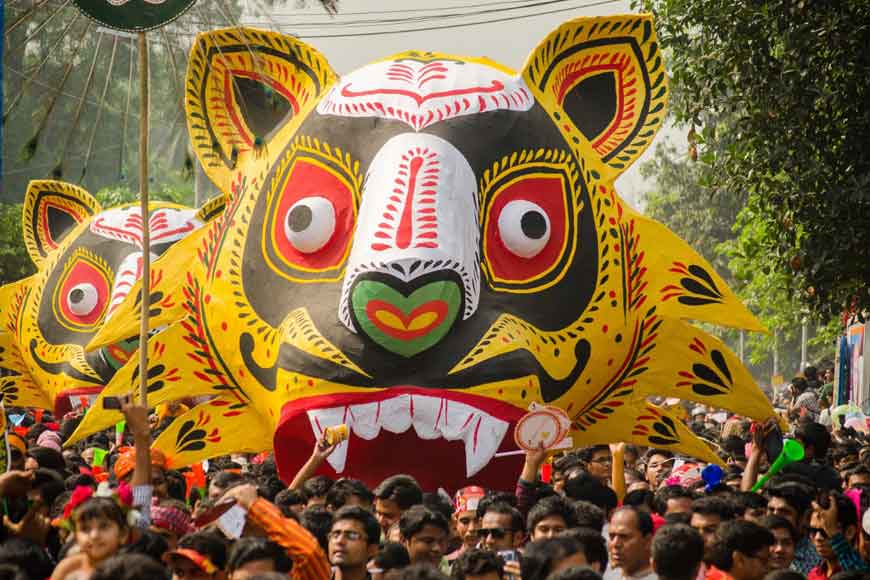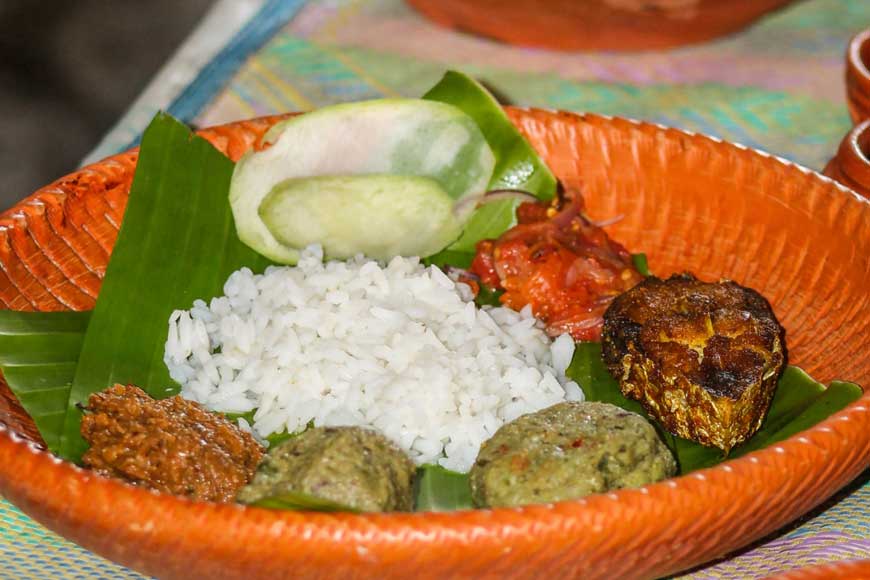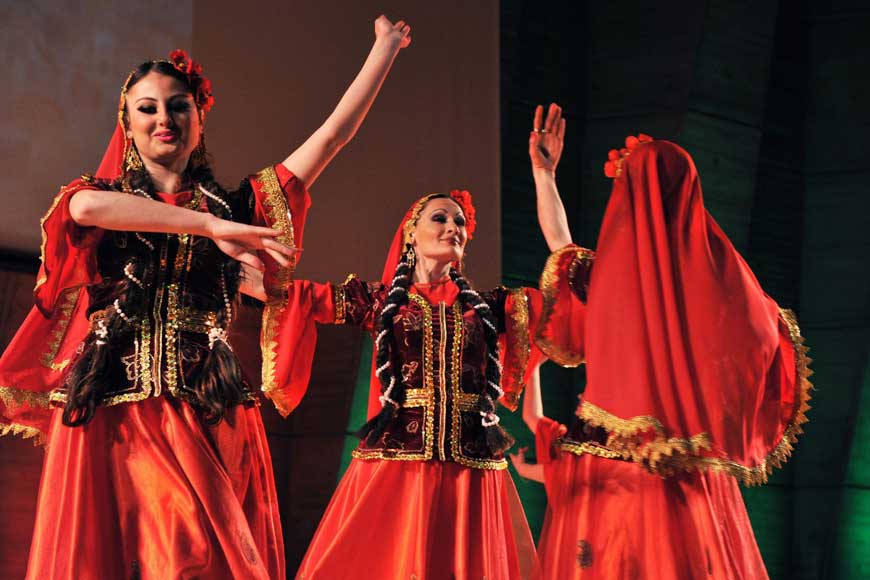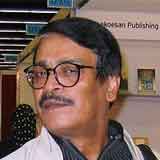Nabo Barsho politics, and culture

Mangal Shobhajatra in Dhaka
History records that the Emperor Akbar harboured no rigid views on religion or community. In fact, quite the reverse. In recent years, however, a few extremist Hindu outfits have begun dragging his name into various issues. Last year, someone from Kolkata told me that the Covid-19 outbreak had cast a shadow on Poila Baisakh celebrations in the city. In passing, I was also informed that a group of ultra-Hindutva vadis had also issued a fatwa of sorts, saying that since the Bengali new year was, in fact, initiated by the Muslim Akbar, all true Hindus must reject it.
All this time, I have been given to believe that the Bengali new year is the most secular festival of Bengali Hindus and Muslims. Not many Bengalis have ever torn their hair out about who actually began the custom of Nabo Barsho, or Bengali new year. Nabo Barsho is primarily a creation of the ethnic culture emanating from the soil of Bengal. It is not born of the city. I have seen the village fairs held to observe Chaitra Sankranti, called ‘Charak Mela’ in some regions. Fairs where Hindus and Muslims gathered equally, where the rural economy was on display as wares were bought and sold, and shops and markets brought out the ‘halkhata’. The accounts of the year gone past were settled, and a new ledger started for the new year. Ethnic culture.
Since 1967, Ramna Park in Dhaka was witness to a special Nabo Barsho programme organised by the music organisation Chhayanat. The prime movers were eminent musicologist Waheedul Haq, renowned Tagore songs vocalist and professor Sanjida Khatun, and a few others. The morning programme comprised a few Tagore songs, a few poems, the whole thing wrapped up in less than an hour.
Rural culture is now disappearing under the onslaught of corporate businesses. Modern culture propagates itself with great ferocity through the smartphone. Music in one’s ear, images on the phone, connections made and broken through WhatsApp, Facebook, Twitter. The ‘Gajon’ of rural Bengal is all but gone. The boatmen no longer sing their ‘Bhatiyali’ songs. The only places you can hear the songs of Abbasuddin or Sachin Dev Burman are YouTube or a CD, perhaps. Nobody goes home to their villages for Poila Baisakh any longer. They used to, even in the 1950s. Their parents and relatives would await their arrival from the city, so that everyone could celebrate Nabo Barsho together. It was also a time of meeting everyone you knew in the village, and eating as many sweets and other food as you could. And it would all end with blessings for the year ahead.
 A panta ilish platter
A panta ilish platter
Halkhata still survives in a few parts of old Dhaka, but it won’t for long. With business now conducted by a new generation, cash has replaced credit. Transactions between big businesses are all about instalments. In some cases, loans are unpaid, some others go bankrupt.
In Kolkata, College Street has a different sort of halkhata. Writers are paid as much of their royalty as possible, though not every publisher is the same. Sweets are on offer to writers as well as customers, though. Dhaka has no such culture. It is a government holiday, and treated as such.
Since 1967, Ramna Park in Dhaka was witness to a special Nabo Barsho programme organised by the music organisation Chhayanat. The prime movers were eminent musicologist Waheedul Haq, renowned Tagore songs vocalist and professor Sanjida Khatun, and a few others. The morning programme comprised a few Tagore songs, a few poems, the whole thing wrapped up in less than an hour. But since the 1990s, Ramna Park (now Suhrawardy Udyan) barely has standing room on Pohela Boishakh. Not just music and other entertainment, it is also the scene of a bustling fair, selling everything from taant saris to nose rings to clay utensils, reflecting Bengal’s various traditions. The men turn up in colourfully embroidered ‘panjabi’s, and then the grand masked procession begins, called the ‘Mangal Shobhajatra’. An explosion of Bengal’s ethnic culture.
The month of Baisakh heralds a new year not just in Bengal, but in other Indian states too. In Assam, they have the Bihu dance festival, Uttar Pradesh celebrates new year too. Sikhs have their Baisakhi, while Buddhists celebrate Baisakhi Purnima, particularly the Buddhist-majority nations of Southeast Asia.
Who was it who came up with the idea of ‘panta-ilish’ (fried hilsa fish with rice soaked overnight in water)? Nobody seems to know, but the story goes that a poor man had the bright idea of selling panta-ilish at a high premium one year, sitting in a corner of a field. Those who couldn’t resist the temptation paid his price and ate the delicious combination, which then became a nationwide rage on this particular day. Trust the impulsive Bengali. As a result, on the eve of Nabo Barsho and on the day itself, hilsa prices hit the stratosphere.
Also read : Paying homage to the soil
Across the world, the new year is celebrated in several countries at the end of March or in the first or second week of April. Once again, it is primarily a display of ethnic culture. In Turkey and the Middle East, I have witnessed ‘Naoroz’ (new year, also called ‘Nairoz’ or ‘Niuroz’ in some regions), and huge fairs lasting from three to seven days in celebration. Not only do these fairs regularly feature music and dance in otherwise Islamic countries, but the women even let out shrill ululations like the ‘uludhwani’ common to Bengal. Asking about this particular custom in Egypt, I was told: “This is our culture, we have it in weddings too. It came to us from Babylon, at least 10,000 years ago.”
 Traditional dancing during Nowruz festival
Traditional dancing during Nowruz festival
The month of Baisakh heralds a new year not just in Bengal, but in other Indian states too. In Assam, they have the Bihu dance festival, Uttar Pradesh celebrates new year too. Sikhs have their Baisakhi, while Buddhists celebrate Baisakhi Purnima, particularly the Buddhist-majority nations of Southeast Asia. In Berlin, we have a five-day celebration of ethnic culture named ‘Karneval der Kulturen’.
In Bangladesh, Islamic hardliners have raised the bogey of ‘Hindu culture’ during Nabo Barsho. Women wear bindis, don’t wear hijab, sing Rabindra Sangeet, and so on and so forth. Cloaked in the garb of religion and politics, this is deep-seated attempt to neutralise Hindu-Muslim camaraderie.
All this time, I have been given to believe that the Bengali new year is the most secular festival of Bengali Hindus and Muslims. Not many Bengalis have ever torn their hair out about who actually began the custom of Nabo Barsho, or Bengali new year. Nabo Barsho is primarily a creation of the ethnic culture emanating from the soil of Bengal. It is not born of the city.
There is a simmering controversy about the correct English date for Nabo Barsho too. Bangladesh celebrates Pohela Boishakh on April 14, West Bengal celebrates Poila Baisakh on April 15. The Bengali year-month-day experts at Dhaka’s Bangla Academy have sifted through countless historical tomes and documents to declare that April 14 is the start of the new year, and no mistake. Why the almanac and history-loving experts of West Bengal are set on April 15, why they haven’t decried Bangladesh’s decision in favour of April 14, is a question. Politics even with the date? Hindu politics of West Bengal? Muslim politics of Bangladesh? Politics of ethnic culture?
Last year and this, we in Berlin, Bengalis from both Bengals, have not been able to get together for the new year owing to the Covid spectre. There has been much lamentation all around. Maeen Choudhury, the renowned singer and Chhayanat artist from Berlin has thus written: ‘Sahe na jatona/ Dur ho corona’ (the pain is not to be borne/Corona will you be gone!)
Translation: Yajnaseni Chakraborty











